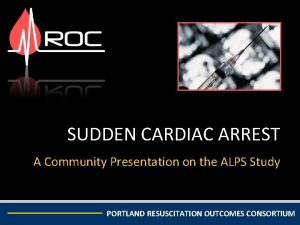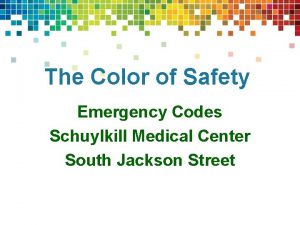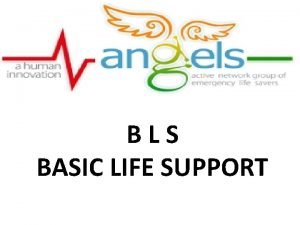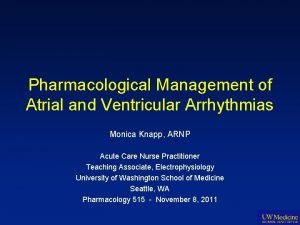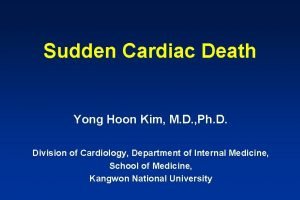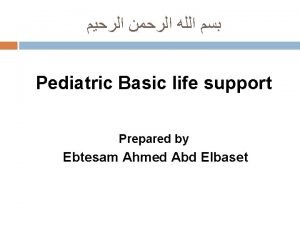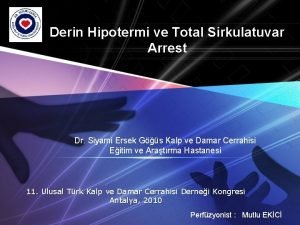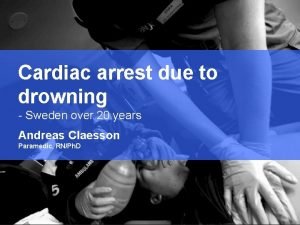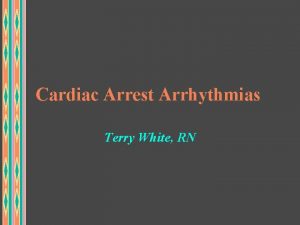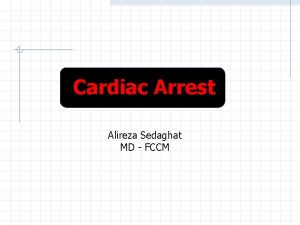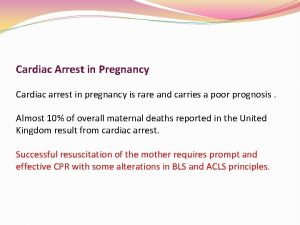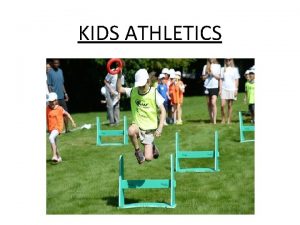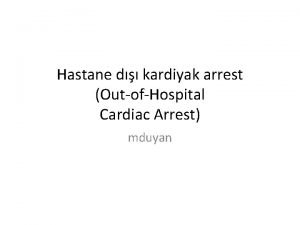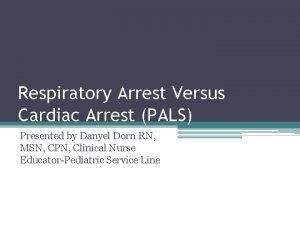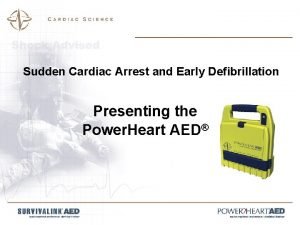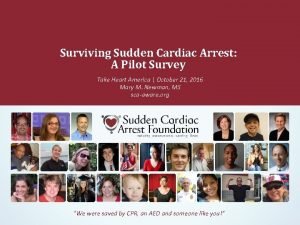Sudden Cardiac Arrest in Intercollegiate Athletics Sudden Cardiac















- Slides: 15

Sudden Cardiac Arrest in Intercollegiate Athletics

Sudden Cardiac Arrest in Intercollegiate Athletics Are you prepared ?

Prevalence of Sudden Cardiac Arrest • SCA affects about 1 in 44, 000 NCAA Student Athletes Annually • Of the deaths from medical causes, 56% were cardiovascular-related sudden deaths • Males have a high incidence than females • Sports at a high risk include(in order) basketball, swimming, lacrosse, football, and cross country • Death rate among Afro-American athletes is 1: 17, 696 compared to 1 in 58, 653 for Caucasian competitors • Division I male basketball players, the rate of SCD was 1: 3100 per year

Recognition of SCA • SCA should be suspected in any athlete who is collapsed and unresponsive • SCA should be suspected in any non-traumatic collapse • Brief seizure-like activity is common after collapse from SCA • Seizure = SCA until proven otherwise • Occasional gasping is not normal breathing… think SCA

Common Causes of SCA Ventricular fibrillation occurs leading to improper heart rhythms Conditions seen include: – Hypertrophic Cardiomyopathy – Congenital Abnormalities of Coronary Arteries

Prevention of SCA Screening • Student-athletes are required to have a preparticipation physical examination. • The PPE includes: Insert institutional screening policy here if applicable o o History (chest pain or passing out with exercise) Physical exam (blood pressure, heart sounds)

Prevention of SCA Emergency Preparation Emergency Action Plan Essential elements of an emergency action plan include: • (insert specific institutional plans for all of the following) • Methods of communication • Personnel requiring CPR and AED training • Locations of AEDs for early defibrillation • Practice and review of the response plan

Emergency Planning Written Emergency Action Plan for SCA Emergency communication system Trained responders in CPR/AED locations – all staff awareness Access to early defibrillation (<3 -5 min collapse to shock) Practice and review of the response plan at least annually Integrate AEDS into local EMS system

Management of SCA • Chain of Survival • Early CPR • Prompt AED usage

Chain of Survival Early Recognition Early CPR Improved Survival Early AED

Early CPR • CPR can double or triple the chance of survival • < 1/3 of SCA victims receive bystander CPR • 2010 AHA guidelines o o Hands-only CPR Chest compressions § § Push hard, push fast (100 per minute) HCP 2 person CPR

Availability of AEDs • The single greatest factor affecting survival is the time from cardiac arrest to defibrillation (shock) • AEDs improve survival through early defibrillation • Survival rate decreases by 10 % for ever minute an AED is not being used

Management of SCA The Collapsed and Unresponsive Athlete • Suspect SCA in any collapsed and unresponsive athlete • An AED should be applied as soon as possible for rhythm analysis and shock if indicated

Sequential Steps in SCA 1. 2. 3. 4. 5. 6. Recognize SCA Call for help / Call 9 -1 -1 Begin chest compressions (CPR) Send bystander to retrieve AED Apply and use the AED as soon as possible Continue CPR until EMS arrives

References • 2013 -14 NCAA Sport Medicine Handbook • K. Harmon, I. Asif, D. Klossner and J. Drezner “Incidence of Sudden Cardiac Death in National Collegiate Athletic Association Athletes”. Circulation. 2011; 123: 1594 -1600; originally published online April 4, 2011 • National Athletic Trainers' Association Position Statement: Preventing Sudden Death in Sports. JAT. 2012 Jan-Feb 47(1) 96 -118 • Journal of American Cardiology; Vol 67; Issue 25, June 2016 DOI: 1016/j. jacc. 2016. 03. 527 • Revised March 2017
 Intercollegiate football association
Intercollegiate football association Difference between games and sports
Difference between games and sports Reason of cardiac arrest
Reason of cardiac arrest Cardiac arrest code color
Cardiac arrest code color In hospital cardiac arrest chain of survival
In hospital cardiac arrest chain of survival Classification of antiarrhythmic drugs with examples
Classification of antiarrhythmic drugs with examples Yong hoon kim
Yong hoon kim Pediatric triangle assessment
Pediatric triangle assessment Derin hipotermik sirkülatuar arrest
Derin hipotermik sirkülatuar arrest Reentri
Reentri Calculate fluid deficit
Calculate fluid deficit Sinus pause
Sinus pause A positioning device system is a fall arrest system
A positioning device system is a fall arrest system How quickly did things get out of hand in salem
How quickly did things get out of hand in salem Bridget riley descending
Bridget riley descending Silver diamine fluoride bottle
Silver diamine fluoride bottle


